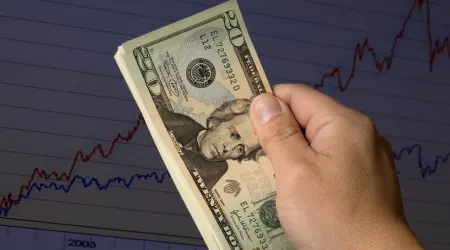Calculating the P/E
Let’s say company ABC has a current share price of $100 and an annual EPS of $10 as stated in its latest report. $100 divided by $10 is a P/E of 10. So, at the current price, you’re expecting to buy 10 years of earnings.
What it is. Offers a snapshot of what you’ll pay for a company’s future earnings. It considers a company’s recent earnings per share (EPS) against the market price. You’ll often see the P/E with a number that is considered a multiple of the company’s earnings.
Best time to use it. When you compare competing companies in the same industry. Investors say that a stock with a lower P/E is cheaper and probably under valued. For example, if Publix had a P/E of 25 and Kroger had a P/E of 12, Kroger would be considered the better value.
Watch out for when a P/E ratio increases dramatically. This could mean investors overshot the expectations about the company’s actual earnings. Investors can get caught up in the market hype, anticipating significant growth, and push the stock price to the point it’s overvalued and due for a correction.
How it’s calculated. Look for a company’s EPS figures on its website. Divide the current price share by the EPS to find the P/E. If the company has adjusted EPS figures, use those instead — any one-time major expense could affect the EPS.
Let’s say company ABC has a current share price of $100 and an annual EPS of $10 as stated in its latest report. $100 divided by $10 is a P/E of 10. So, at the current price, you’re expecting to buy 10 years of earnings.
While there’s no definitive P/E that’s considered “good,” over the last century the S&P 500 has averaged a P/E of slightly more than 15, which is sometimes seen as a broad threshold for fair value.
What it is. Considers a company’s earnings growth. Find the estimated earnings per share over the next year — included in the latest report.
When to use it. To compare peer performance of companies in the same industry.
What to watch out for. There’s no set PEG ratio that’s considered a definite “buy” signal, but some may treat a stock with a PEG ratio below 1 as undervalued.
How it’s calculated. Use the P/E ratio and divide it by the growth in earnings per share (EPS).
Company ABC has an estimated EPS of $11 over the next year as stated in its report. This is an increase of 10% over its current EPS of $10. Using the PEG formula of the P/E (10) divided by growth in EPS (10%), we have a PEG of 1.
What it is. A snapshot of the value of a company’s assets.
When to use it. The closer the P/B ratio is to 1 (or below), the greater the perceived value of the stock. P/B is mostly used for mature companies with limited growth or companies whose goal is to accumulate assets rather than sell products.
How it’s calculated. Divide the current share price by the stock’s book value. Then divide by the number of shares issued. The book value is worked out from the balance sheet as total assets minus total liabilities (or costs). The balance sheet with these figures can be found in the company’s latest earnings report on its website.
Consider company XYZ. Its market price is currently $2, with 50 million shares issued. Total assets are $80 million and total liabilities are $20 million (this equals a book value of $60 million). Therefore, the P/B ratio is: $2 divided by ($60 million / 50 million) = 1.7
What it is. A way for investors to see how much cash is left over after everything’s been paid. FCF skips much of the complexity of accounting and provides a clear view of how well the business is creating value.
When to use it. Compare it as a raw number or as a ratio of FCF divided by total revenue to give you an idea of what percentage of every dollar of income turns into profit.
How it’s calculated. FCF is the net cash from operating activities minus its capital expenditures.
Companies create value and make money in different ways, so valuation ratios often depend on the company and industry. For example, a bank is valued by how many assets it has and how well it grows those assets, so the price-to-book ratio is a good measure of value. Retailers, on the other hand, aren’t looking to accumulate assets — they’re trying to sell products and make a profit. So price-to-sales or price-to-earnings ratios would be better measures of value.
In addition to the ratios above, which give you an idea of a stock’s relative value in line with similar companies, there are a couple more tips to help you figure out if a stock is priced fairly.
While relying on these analyst reports to determine intrinsic value or investment opportunities could be unwise, these reports may offer a more broad picture of a stock’s fundamentals.
No one wants to pay more than they need to. The basic goal of investing in stocks is to buy when the price is low and sell when it’s high to make a profit.
Valuing a company’s shares against similar companies in the market is one of the easiest ways to do this. It can help you figure out if you’re potentially paying too much for a stock, if you’ve found a bargain buy or if you’re holding onto a potentially overvalued stock.
Check out Finder's picks for the best brokerage accounts
Compare top brokerage accounts and apps to help you maximize your investment.
Response | % of investors |
|---|---|
| More conservatively (lower risk, lower return) | 34% |
| More adventurously (higher risk, higher return) | 8% |
| About the same | 58% |
About a third (34%) of investors said that they investing more conservatively than they were 6 months ago.

These are the stocks to buy when you don’t have much to spend.
Read more…
Here’s what happens to your securities if your brokerage fails, and how your assets are protected by SIPC and FDIC.
Read more…
Treasury Bills are fixed-income assets with maturities of less than one year. Here’s what to know before investing.
Read more…Paid non-client promotion. Finder does not invest money with providers on this page. If a brand is a referral partner, we're paid when you click or tap through to, open an account with or provide your contact information to the provider. Partnerships are not a recommendation for you to invest with any one company. Learn more about how we make money.
Finder is not an advisor or brokerage service. Information on this page is for educational purposes only and not a recommendation to invest with any one company, trade specific stocks or fund specific investments. All editorial opinions are our own.
Some of the best paper trading apps to practice stock trading with fake money include Interactive Brokers, eToro, Charles Schwab and more.
These are the stocks to buy when you don’t have much to spend.
These are the best day trading apps, according to Finder’s comprehensive analysis.
Explore the best bonuses for opening a new brokerage account.
Some of the best stock trading apps for beginners include SoFi, Robinhood, Public, Stash, Opto and more. Compare your options here.
Want to buy and sell international stocks? Here are the top brokers to help you trade global markets.
These are the best discount brokers of 2025 according to Finder’s comprehensive review.
Compare the 7 best stock picking services, according to Finder’s analysis, and learn how to choose the best option for your needs.
Check out our picks of the best trading apps for beginners, options traders, hands-off investors and more.
We’ve rounded up stats on some of the most popular graphene stocks, along with information on how they compare and how to invest.